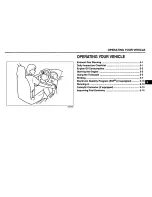
Section 16: SUPPLEMENT INFORMATION ON INDEPENDENT FRONT SUSPENSION (IFS)
16-11
8.
Align nut with cotter pin slot (tighten) and
install a new cotter pin.
Note:
Bend cotter pin around the nut
(Fig. 8). Do not bend the cotter pin in the di-
rection of the cap, because it may interfere
with the cap.
9.
Apply anti-seize compound PREVOST #
640064 on screws' threads. Install the cap
screws. Torque cap screws to 8 lbf•ft
(11 N•m).
10.
Bell crank : Install drag link, tie rod and
relay rod as directed herein under each
specific subject.
11.
Idler arm : Install tie rod and relay rod as
directed herein under each specific sub-
ject.
12.
Adjust turning angle as previously directed
under paragraph "2.2 Turning Angle" and
check front end alignment as specified in
paragraph "4. Front End Alignment" of this
supplement.
2.7 Relay Rod
Relay rod ends are equipped with lubrication
fittings and should be lubricated as directed in
paragraph "2.10 LUBRICATION FITTINGS" in
this supplement.
2.7.1 Replacement
1.
Remove cotter pins from bell crank and
idler arm end of relay rod. Loosen nuts
flush with end of studs.
2.
Place a sledge hammer behind the adja-
cent part to absorb shocks. Strike the
studs with a brass hammer to loosen end
assemblies.
3.
Remove stud nuts and washers then
remove studs.
4.
Position relay rod studs into bell crank
and idler arm then tap stud ends with a
brass hammer to seat tapered surfaces.
5.
Install washers and stud nuts. Tighten
nuts to 160 lbf•ft (217 N•m) torque. Align
cotter pin slot (tighten) and install a new
cotter pin.
2.8 TIE RODS
2.8.1 Description And Maintenance
Tie rod ends are connected to the bell crank
and left steering arm, and to the idler arm and
right steering arm. Each tie rod assembly
consists of three parts; a tube and two socket
end assemblies. The tie rod ends are
threaded into the tube and secured with
clamp bolts. Right and left hand threads are
provided to ease toe-in adjustment. Tie rod
assemblies are interchangeable from the right
to the left side of the coach.
Tie rod end sockets require no maintenance
other than periodic lubrication and inspection
to see that ball studs are tight. Replace socket
ends when there is excessive up and down
motion, lost motion or end play at ball end of
stud.
1.
Periodically check bolt nut for tightness.
2.
Inspect tie rod for bent condition and
inspect tube for damaged threads. If tie
rod is bent or threads are damaged, re-
place the assembly.
3.
Lubricate tie rod end fittings as directed in
paragraph "2.10 LUBRICATION FIT-
TINGS" at the end of this section.
2.8.2 Removal
1.
Remove cotter pins and stud nuts which
attach tie rod socket ends to bell crank
and left steering arm (or idler arm) and
right steering arm.
2.
Remove tie rod ball stud by tapping on
steering arm and bell crank or idler arm
with hammer, while using a sledge ham-
mer to absorb shocks.
Note:
If tie rod end assemblies are damaged
in any way, they must be replaced.
2.8.3 Installation
1.
Install socket end assemblies on tie rod.
Be sure both ends are threaded an equal
distance into the tube.
2.
Make sure threads on stud and in stud
nut are clean and not damaged.
Содержание GKN AXLES LIMITED KIRKSTALL DIVISION
Страница 24: ...Section 16 SUPPLEMENT INFORMATION ON INDEPENDENT FRONT SUSPENSION IFS 16 7 FIGURE 6 CLAMPS POSITIONING 16041...
Страница 32: ...Section 16 SUPPLEMENT INFORMATION ON INDEPENDENT FRONT SUSPENSION IFS 16 15 FIGURE 12 BALL JOINT 16047...
Страница 36: ...Section 16 SUPPLEMENT INFORMATION ON INDEPENDENT FRONT SUSPENSION IFS 16 19 FIGURE 14 BALL JOINT 16049...
Страница 66: ...12 FIGURE 8 HUB UNIT AND STUB AXLE 10023...
















































